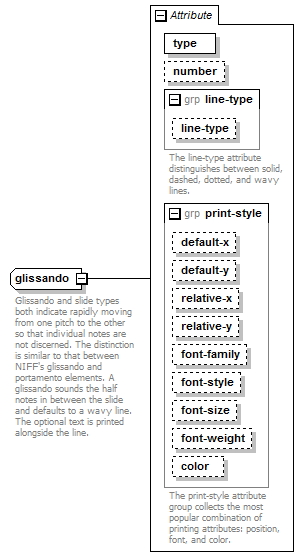glissando
Glissando and slide types both indicate rapidly moving from one pitch to the other so that individual notes are not discerned. The distinction is similar to that between NIFF's glissando and portamento elements. A glissando sounds the half notes in between the slide and defaults to a wavy line. The optional text is printed alongside the line. |
Complex Type Information
Model

Attributes
| QName | Type | Fixed | Default | Use | Inheritable | Annotation |
|---|---|---|---|---|---|---|
| color | color | optional | ||||
| default-x | tenths | optional | ||||
| default-y | tenths | optional | ||||
| font-family | comma-separated-text | optional | ||||
| font-size | font-size | optional | ||||
| font-style | font-style | optional | ||||
| font-weight | font-weight | optional | ||||
| line-type | line-type | optional | ||||
| number | number-level | 1 | optional | |||
| relative-x | tenths | optional | ||||
| relative-y | tenths | optional | ||||
| type | start-stop | required |
Used By
| Element | notations/glissando |
Source
<xs:complexType name="glissando"> <xs:annotation> <xs:documentation>Glissando and slide types both indicate rapidly moving from one pitch to the other so that individual notes are not discerned. The distinction is similar to that between NIFF's glissando and portamento elements. A glissando sounds the half notes in between the slide and defaults to a wavy line. The optional text is printed alongside the line.</xs:documentation> </xs:annotation> <xs:simpleContent> <xs:extension base="xs:string"> <xs:attribute name="type" type="start-stop" use="required"/> <xs:attribute name="number" type="number-level" default="1"/> <xs:attributeGroup ref="line-type"/> <xs:attributeGroup ref="print-style"/> </xs:extension> </xs:simpleContent> </xs:complexType> |